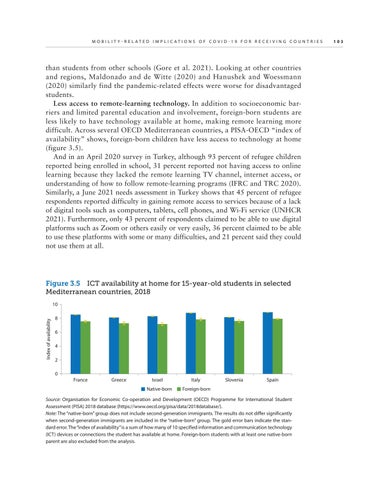M o b i l i t y - R e l a t e d I m p l i ca t i o n s o f C OVID - 1 9 f o r R e c e i v i n g C o u n t r i e s
than students from other schools (Gore et al. 2021). Looking at other countries and regions, Maldonado and de Witte (2020) and Hanushek and Woessmann (2020) similarly find the pandemic-related effects were worse for disadvantaged students. Less access to remote-learning technology. In addition to socioeconomic barriers and limited parental education and involvement, foreign-born students are less likely to have technology available at home, making remote learning more difficult. Across several OECD Mediterranean countries, a PISA-OECD “index of availability” shows, foreign-born children have less access to technology at home (figure 3.5). And in an April 2020 survey in Turkey, although 93 percent of refugee children reported being enrolled in school, 31 percent reported not having access to online learning because they lacked the remote learning TV channel, internet access, or understanding of how to follow remote-learning programs (IFRC and TRC 2020). Similarly, a June 2021 needs assessment in Turkey shows that 45 percent of refugee respondents reported difficulty in gaining remote access to services because of a lack of digital tools such as computers, tablets, cell phones, and Wi-Fi service (UNHCR 2021). Furthermore, only 43 percent of respondents claimed to be able to use digital platforms such as Zoom or others easily or very easily, 36 percent claimed to be able to use these platforms with some or many difficulties, and 21 percent said they could not use them at all.
Figure 3.5 ICT availability at home for 15-year-old students in selected Mediterranean countries, 2018
Index of availability
10 8 6 4 2 0
France
Greece
Israel Native-born
Italy
Slovenia
Spain
Foreign-born
Source: Organisation for Economic Co-operation and Development (OECD) Programme for International Student Assessment (PISA) 2018 database (https://www.oecd.org/pisa/data/2018database/). Note: The “native-born” group does not include second-generation immigrants. The results do not differ significantly when second-generation immigrants are included in the “native-born” group. The gold error bars indicate the standard error. The “index of availability” is a sum of how many of 10 specified information and communication technology (ICT) devices or connections the student has available at home. Foreign-born students with at least one native-born parent are also excluded from the analysis.
103

